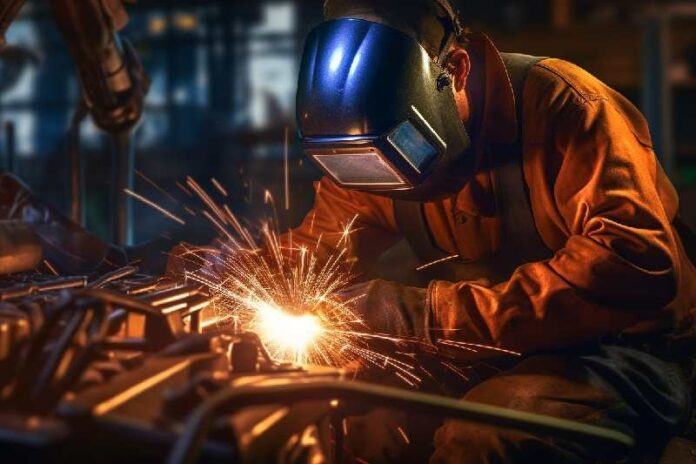
Let’s talk oxy-acetylene welding! It is the most common welding process when it comes to thin metal plates and heating tasks, but before we get ahead of ourselves, let’s first frame this blog and ask the right questions. What defines Oxy-Acetylene Welding?
What are its main principles? What makes it different from other wending types? And finally, what is its essential equipment for a safe and efficient implementation?
Welding processes can differ widely. Your choice will depend on the environment, what industrial gases you’re using, and the types of materials you intend to fuse.
The most widely used processes are flux-cored welding, GMAW/MIG welding, GTAW/TIG welding, SMAW welding, and of course, our main subject today oxy-acetylene welding.
Also known as oxy-fuel welding, the term refers to the combustion of oxygen and a very popular Industrial gas among welding gas suppliers and welders alike, namely, acetylene. The process can also be called “gas welding.” considering that the fuel involved in the process is in gas form.
Now as an aspiring welder, you might ask, when is it used? The answer is simple,
Oxy-acetylene welding is typically used for welding thin metal sections. It is also popular for heating tasks, in case you’re struggling with some frozen bolts and nuts or have some soft soldering tasks.
The process of oxy-acetylene welding, known for its adaptability and leniency, is the go-to choice for novice and occasional welders. Thanks to its transportable and user-friendly equipment. Especially when compared with other heavier and more demanding welding types.
How Does Oxy-Acetylene Welding Work?
The simple answer is burning Oxygen with acetylene, which results in a high-temperature flame. The pure oxygen flame emerges from the welding torch tip, also known as the oxy-acetylene torch welding. It is naturally used to melt the welded material with the filler rod.
Both the fuel gas (in this case, Acetylene) and oxygen are stored in the pressurized steel cylinders equipped with regulation valves to decrease the gas exit pressure, the gas is then funneled through flexible hoses. Using the torch, the welder can control the gas flow, and the flame intensity as well.
The rest is pretty obvious, the flame melts and joins the filter rod with the metal pieces. Depending on the situation, gas welding can also be used to merge two pieces of metal without using a filler rod.
What Distinguishes Oxy-Acetylene Welding from Other Welding Types?
Oxy-Acetylene welding is different from other types of welding because it uses a flame rather than electricity to heat and melt the metal. Oxy-Acetylene welding uses burning gases that reach about 6,000 degrees Fahrenheit.
Arc welding methods like SMAW, FCAW, GMAW, and GTAW instead use an electric arc that reaches around 10,000 degrees Fahrenheit.
In the past, Oxy-Acetylene welding was used for welding all kinds of metal, both thin and thick. But over time, it has mainly been used just for thin metals. Even in thin metals, it is slowly being replaced by GTAW welding, an electricity-based welding process.
What are the Typical Oxy-Acetylene Welding Equipment?
To perform Oxy-Acetylene Welding safely and efficiently, you will need the following components
Cylinders
Steel containers, where pressurized gas and oxygen are stored
Regulators
Regulators are used to control the flow of fuel and oxygen out of the cylinders and into the hoses, and bring the pressure down to a working level,
Hoses
Hoses connect the cylinders with the torch, they have to be nonporous, and to avoid any confusion or installation mistakes, the oxygen hose is usually green, while the fuel one is red.
Hose fittings
These include several different safety measures, to avoid dangerous entanglements, it’s advised to use Siamese hoses (a pair of hoses that have been welded together), or you can simply tape the two hoses together.
Notice that Oxygen hoses come fitted with right-hand threaded, while gas hoses usually have left-hand threaded fittings.
After installation, Welders should check Hose connections from each side, and make sure that there is no leaking.
Finally, and perhaps most importantly, welders are advised to use Regulator-mounted and torch-mounted flash arrestors for both oxygen and fuel hoses. These flash arrestors will prevent flashes and backfires from going backward into the hoses or, god forbid, the cylinders.
Safety valves
Keeping gas flowing in the right direction is crucial for a successful and safe welding operation, and that’s where safety valves come into play. They also play an important role in reducing the possibility of flashbacks
Torches
Torches are pretty self-explanatory, that’s where the oxygen meets fuel and the flame is produced. They have various designs, but the main feature that you should always look for is the ability to control the flame
Tips
Welders are required to familiarize themselves with as many tip sizes as possible. And that is due to the absence of a standardized tip size identification system. To make this easier, tip sizes are comparable to numbered drill sizes. Some torch sets come with tips that have their own mixing chambers.
If you wish to take up welding as a hobby, Oxy-Acetylene Welding is the perfect place to start; with reliable equipment and attention to safety measures, you will surely start making art in no time. And remember, keep those eyes protected, welding burns is no joke!





